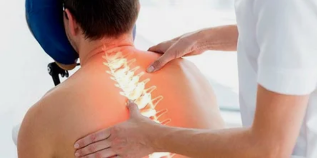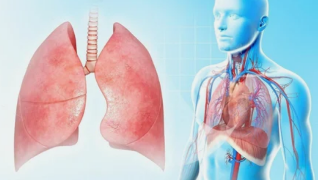Chest osteochondrosis is a condition that is diagnosed quite often. Statistics show that it represents about 40% of all diseases of the musculoskeletal system. In the initial stages, a person may not be aware of their pathology for a long time.
Over time, he develops severe painful sensations that are localized in the thoracic spine. If you do not start timely full treatment, there is a possibility of serious complications. The biggest danger is a respiratory disorder.
Classification

Chest osteochondrosis is a disease that is quite common in elderly patients. If you do not start full therapy in time, there is a possibility of serious complications.
Before starting treatment, the doctor must accurately classify the nature of the pathology. It could be:
- Dorsago - Painful sensations arise from impulses that occasionally appear in the chest. Usually this discomfort begins after a long stay in one position. A person faces difficulty breathing, while virtually no action can be performed with his head. If he manages to move, then the pain pierces the entire spine.
- Dorsalgia is a pathology in which prolonged attacks of pain occur. On average, they can last up to these weeks. This condition usually occurs due to severe damage to the intervertebral discs. During exacerbations, you should lead an inactive lifestyle and refuse any activity. The pain increases significantly at night.
Causes of pathology
However,Osteochondrosis of the chest can occur in absolutely anyone at any age.

The following groups of people are at increased risk:
- Leading an inactive lifestyle. If you do not exercise, metabolic processes are disrupted. Because of them, the human spine begins to accumulate deposits that begin to squeeze the nerve endings. The discomfort increases significantly with the degree of degenerative destruction.
- Overweight - every extra pound brings extra strain on the spine. The heavier you are, the heavier your spine becomes.
- Smokers - due to cigarettes the blood circulation in the body is disturbed, due to which the tissues of the spine do not receive enough useful elements.
- Leading an overly active lifestyle. Especially often the thoracic spine suffers from frequent lifting of heavy weights.
- Various posture disorders. A curved spine is not able to properly distribute the load that causes the chest area to suffer.
Manifestations
The initial stage of osteochondrosis of the chest is characterized by an extremely long period. For a long time one may not notice any painful sensations. Here lies the danger of pathology, as only in the first stage it is actively treated.
In most cases, the development of osteochondrosis can be recognized by the following manifestations:
- Tightness of the posterior muscle corset;
- Dull pain located between the shoulder blades;
- Feeling of increased pressure in the chest area;
- Pain that occurs during palpation of the spinous processes;
- Pain that can radiate to other parts of the body.

A person with osteochondrosis of the thoracic spine often has limited mobility in the morning. Crunching can also occur in certain parts of the sternum.
Often a person encounters tingling in the limbs, his posture begins to deteriorate rapidly - this is due to excessive tension in the muscle tissue. In addition, sharp cutting pain may occur, which is localized in the intercostal spaces.
To date, official medicine has not been able to find effective means to repair damaged intervertebral discs, so it is imperative to consult a chiropractor. Approach the choice of a specialist responsibly, as any incorrect movement can cause serious complications.
Methods of treatment
Before starting treatment for osteochondrosis of the thoracic spine, it is necessary to undergo an advanced diagnosis. With its help it is possible to accurately determine the location of the degenerative process, which can provide more effective and high quality treatment. Please note that only your doctor can prescribe medication. There are a huge number of different drugs that differ in their principle of action.
First, you will be prescribed painkillers - steroidal anti-inflammatory drugs. They stop the production of arousal mediators, which makes a person feel much better.
Please note that the patient should be under the constant supervision of the treating physician during treatment.
In order to achieve the maximum effect of the treatment of osteochondrosis of the thoracic spine, the therapy should be carried out in combination. You don't have to limit yourself to drugs. Treatment should be performed with physical therapy and sports activities.
Medicine

Drug therapy is most important in the treatment of osteochondrosis of the chest. With the help of various drugs it is possible to stop the painful sensations as soon as possible.
It is also recommended that you adhere to bed rest during recovery. Be sure to consult a qualified health care provider who can prescribe a safe and highly effective treatment regimen.
In general, the treatment of osteochondrosis of the chest involves the use of the following drugs:
- Analgesics - allow you to quickly stop the acute pain syndrome. It also prevents the development of respiratory failures, which often cause complications;
- Antispasmodics;
- Vitamin preparations based on B vitamins. They normalize metabolic processes, prevent degenerative changes.
Effective exercise
Special exercises are able to deal with the manifestations of osteochondrosis of the chest. They should be done regularly - only then can you get significant results from the approaches.
Keep in mind that before starting such treatment, you should definitely consult an experienced specialist. He will tell you which complexes are best for you. Even breathing exercises with osteochondrosis of the chest area have a positive effect on human well-being.
The following exercises should be done:
- Board - lie on the floor, crawl to the wall. Throw your feet on the wall so that they are parallel to it. Stitch in a similar position for 1, 5 minutes to begin. Each time the number of approaches can increase.
- Hang on a horizontal bar regularly. This will help you build the spaces between the intervertebral discs, which will make you feel much better.
- Lie on your back with your legs as close to your chest as possible and hold for a few seconds. This posture can relieve tension in the spinal muscles, thus relieving pain.
For more successful treatment of osteochondrosis of the thoracic region it is necessary to engage in physical education. It is best to go to the exercise clinic, where you will do everything under the supervision of your doctor. Be extremely careful when exercising. Any incorrect movement can easily lead to injury.
Manual therapy
Manual therapy is a unique method of affecting a person's back, in which the chest area completely gets rid of painful sensations. With the right and regular approach you will be able to completely get rid of painful sensations, tension.
In addition, manual therapy contributes to the complete restoration of blood circulation. The active ingredients begin to spread rapidly through the tissues, after which a person feels much better.
Massages
Massage is a method of action in which the doctor activates metabolic processes with his hands. It can be performed both at home and in a hospital.

Massage movements achieve the following results:
- Elimination of increased muscle tone;
- Strengthening the intervertebral discs;
- Accelerates the start of a full recovery;
- Promotes the improvement of metabolic processes.
Physiotherapy procedures
Various physiotherapy procedures will help to deal with the manifestations of osteochondrosis of the chest.
They not only fight painful sensations, but also contribute to the normalization of internal processes. Currently, the most popular are the following procedures:
- Plasma injections. Part of the blood is taken from a person from whom plasma is released. It is injected in pure form directly into the tissues of the spine, so it is possible to get rid of painful sensations.
- Blended massage is a type of vacuum effect on the body that is able to relieve pain and increased muscle tone in a short time.
- Magnetotherapy - exposure of the spine to a magnetic field. The procedure allows you to stop the degenerative process and improve metabolic processes. It also relieves swelling and inflammation.
- Alliterapy is an innovative treatment that uses bees. The insect must bite the person directly in the affected area. This starts the metabolic processes, accelerates the removal of toxins and toxins.
- Treatment with cal. This helps to nourish the spine with beneficial substances that prevent the development of degenerative changes in the human body.
- Spinal block - the use of special injections that relieve pain. Keep in mind that such drugs should be used in the course.
What can go wrong with chest osteochondrosis?

Chest osteochondrosis is a disease whose manifestations can be easily confused with a number of other diseases. Its symptoms may resemble:
- Angina pectoris and heart attack. However, the patient's cardiogram is normal and the use of drugs to normalize blood pressure does not bring any results;
- Renal colic, appendicitis or cholecystitis;
- Diseases of the mammary glands;
- Ulcer, gastritis and colitis;
- Inflammation of the lungs.
Prevention of thoracic osteochondrosis of the spine
Osteochondrosis in the chest is a dangerous disease, due to which the quality of life of each person is significantly reduced. If you start to adhere to preventive measures in a timely manner, the likelihood of complications will be significantly reduced.
Many doctors strongly recommend following the following tips:
- If you work on the computer for a long time, get up from the table every hour and do a light warm-up. This will help normalize blood circulation and prevent stagnation.
- Keep your back warm at all times. For this reason, give up cold showers and short clothes. Always keep it warm.
- Regularly drink vitamin complexes that restore the structure of damaged tissues.
- Take a horizontal position for at least 30 minutes in the middle of the day. This will help the spine to line up, which will make it easier to deal with stress.
- Exercise regularly. Muscle tone has a beneficial effect on the condition of the back.

























